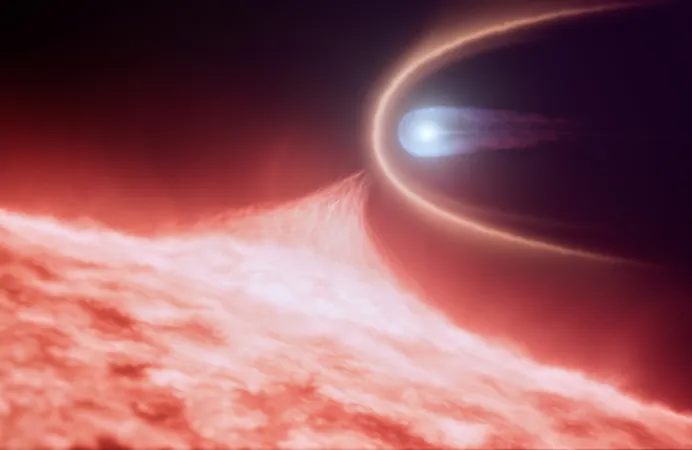
Shocking Discovery: Hubble Reveals a White Dwarf Born from Stellar Collision!
2025-08-17
Author: Benjamin
Unexpected Origins of a White Dwarf
Astronomers have made an astonishing discovery about a star known as WD 0525+526, which at first glance appears to be just another white dwarf. However, detailed investigations revealed its dramatic origins—a violent collision of two stars that merged into this compact celestial body.
What Makes This White Dwarf Unique?
White dwarfs typically signify the end of a star’s life cycle, particularly for stars similar in size to our Sun. These stellar remnants are extremely dense, packing more mass than the Sun into a volume not much larger than Earth. While most are born from a single star’s collapse, WD 0525+526 has a rare and explosive backstory.
The Unveiling of a Stellar Collision
Thanks to NASA’s Hubble Space Telescope, astronomers uncovered ultraviolet evidence confirming that WD 0525+526 originated from a stellar collision. Boris Gaensicke, the principal investigator of the Hubble program, remarked, "This discovery emphasizes that appearances can be deceiving. Hubble's ultraviolet vision has exposed a history we wouldn’t have suspected."
A Closer Look at WD 0525+526
Located 128 light-years away, WD 0525+526 is 20% heavier than our Sun. While it bears the typical characteristics of a white dwarf, the Hubble Telescope's capabilities enabled scientists to analyze its atmospheric composition, revealing the unexpected presence of carbon—a rarity in white dwarfs formed from a single star.
The Process Behind Carbon Visibility
In most white dwarfs, hydrogen and helium dominate the atmosphere, with carbon and oxygen concealed within. However, during the merger of two stars, their explosive collision can strip away these outer layers, allowing carbon to seep upward and become apparent. This phenomenon makes WD 0525+526 an extraordinary case.
How Was Carbon Detected?
At nearly 21,000 kelvins (approximately 37,000 degrees Fahrenheit), WD 0525+526's heat prevents the usual convection that would stir carbon into its atmosphere. Instead, researchers suggest a gentler process called semi-convection is responsible for this carbon surface presence. Amazingly, the quantity of carbon detected was about 100,000 times less than in other known merger products, making it a challenging find without Hubble’s specialized UV instruments.
The Ongoing Quest for Hidden Merger Survivors
This discovery not only sheds light on the origins of WD 0525+526 but also opens the door to identifying other hidden merger remnants throughout our galaxy. Building on previous studies from ESA's Gaia mission, researchers are now eager to determine how widespread carbon-dominated white dwarfs might be and how many stellar mergers are hidden among these ordinary-looking white dwarfs.
A Step Toward Understanding Cosmic Events
The findings, published in Nature Astronomy, pave the way for further exploration into white dwarf binaries and their evolution, potentially enhancing our grasp of stellar explosions like supernovae. The cosmos continues to surprise us, and who knows what spectacular secrets await in the night sky?









 Brasil (PT)
Brasil (PT)
 Canada (EN)
Canada (EN)
 Chile (ES)
Chile (ES)
 Česko (CS)
Česko (CS)
 대한민국 (KO)
대한민국 (KO)
 España (ES)
España (ES)
 France (FR)
France (FR)
 Hong Kong (EN)
Hong Kong (EN)
 Italia (IT)
Italia (IT)
 日本 (JA)
日本 (JA)
 Magyarország (HU)
Magyarország (HU)
 Norge (NO)
Norge (NO)
 Polska (PL)
Polska (PL)
 Schweiz (DE)
Schweiz (DE)
 Singapore (EN)
Singapore (EN)
 Sverige (SV)
Sverige (SV)
 Suomi (FI)
Suomi (FI)
 Türkiye (TR)
Türkiye (TR)
 الإمارات العربية المتحدة (AR)
الإمارات العربية المتحدة (AR)